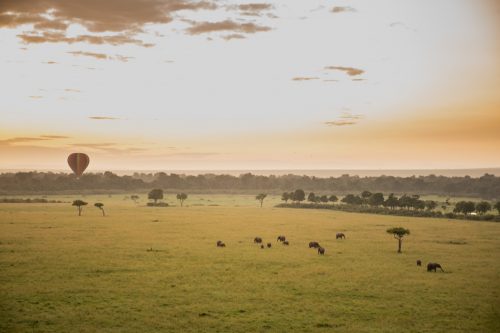While floating on a balloon above the endless plains of the Mara, time seems irrelevant; suspended somewhere between a fleeting moment and eternity. Recently, entire areas have become active marshlands with grass underwater due to heavy rains — even a main road in the Muguro Area was flooded, among other impassable roads.
The distinct gaze of the Angama lioness seems to show her difficult past — losing her entire pride — in the intense look of her eyes. Her cubs are getting older by the day and as they grow their chances of survival increase; we are yet to know if the cubs are male or female but we are hoping they are female so the pride can grow again. We're still not certain who the father is but during sunrise, not far from them, the young Owino male was seen with her just down the Oloololo Escarpment.
The natural cycle of life and death is at play every day. This week, Robert from the Photographic Studio drove to the 4x4 Area to find some young members of the River Pride (an off-shoot of the famous Marsh Pride) attacking a large buffalo in a pool of water. The three lionesses and one male were able to injure one of the buffalo's legs and it could not move. They were scared to approach its head because of its horns so they began feeding on its back until its head slowly slipped under water. At this age, to take down a buffalo is quite impressive — it is a good sign for their future. The next day, less than 24 hours later, I drove to the same area only to find two different clans of hyena feeding on what was left, which was only some bones.
The Bila Shaka boys haven’t been seen for some time but some were recently spotted in the Triangle in the Nyororo Area. Of the two, one was undeniably identified as Chongo, because of his missing eye and dark mane. Their return could bring about a lot of drama in the lion world, having ceded so much territory in their absence, so we'll be sure to keep a close eye on their movements.
Something that draws people to this place is the unexpected — as there is no script, the wildlife encounters are filled with anticipation and excitement. I witnessed the fascinating and skilful behaviour of a ground hornbill. The combination of potent weaponry in the form of a deadly beak, cooperative hunting and strategic adaptability make these birds skilled hunters, along with their keen sense of sight and ability to detect vibrations in the grass as they carefully tiptoe. We saw a male that had stashed something in the grass while hunting something else. It then came back and put all that it had caught in its mouth — it was two different species of snakes, a frog and a grasshopper! -Andrew Andrawes
Night game drives often provide a thrilling and unique safari experience. Lately, in Kimana Sanctuary, we've been fortunate to encounter feline guests — or perhaps they've been here all along. Just as we were about to call it a day, Angama guide, Salaash, spotted a young male lion resting in the bushes just metres from Angama’s airfield.
Equipped with fully charged cameras, we are always prepared to capture the spontaneity of what a night in the wild has to offer. We found him on the move, taking advantage of the full moon.
He appeared to be interested in hunting, so we decided to linger and observe. Before long, he discovered a puddle to quench his thirst and then he returned to sleep in the nearby bushes, suggesting that he would unlikely hunt that night, so we let him enjoy his snooze. We are yet to identify this male lion but he is most likely from Amboseli National Park.
A laid-back safari like we have in Kimana allows you to appreciate every wild creature. I recently spent a little more time than I normally would observing baboons. These social primates exhibit complex social behaviour characterised by hierarchical structures and strong social bonds, which is always interesting to watch. They live in large groups called 'troops', which can consist of several dozen to over a hundred individuals. The social hierarchy is determined by factors such as age, gender and social relationships.
Females usually remain in their natal groups throughout their lives, while males may leave to join other troops. Within each group, there is a dominant male who leads and protects everyone, with a strict ranking order below him. Grooming is another essential aspect of their social interactions, promoting and reinforcing social bonds.
Ostriches are fascinating creatures, and their reproduction (as seen a few weeks ago) and nesting behaviours are quite adaptable. Ostrich nests, often referred to as 'dump nests,' are basic hollows about 30-60cm deep and up to 3m wide, designed to keep eggs in place. Males take charge of selecting and building the nests, sometimes opting for easily noticeable locations, like this one that chose a nesting site right next to a road.
In contrast to many birds, ostrich nests lack any lining and are simply scraped into the ground. These birds prefer communal nesting, with multiple females laying their eggs in a shared nest. These nests typically contain around 20 eggs, though here in Kimana Sanctuary, we have observed nests with fewer and some with more.
Incubation lasts approximately 42 to 46 days, and both male and female ostriches play a role in this process. Despite the communal nesting practice, some ostriches opt for solitary reproduction, forming pairs for nesting. This variety in nesting habits adds to the intriguing nature of ostrich reproductive behaviour. -Sammy Njoroge
Filed under: This Week at Angama
Subscribe for Weekly Stories
Comments (0):

Hot-air Ballooning